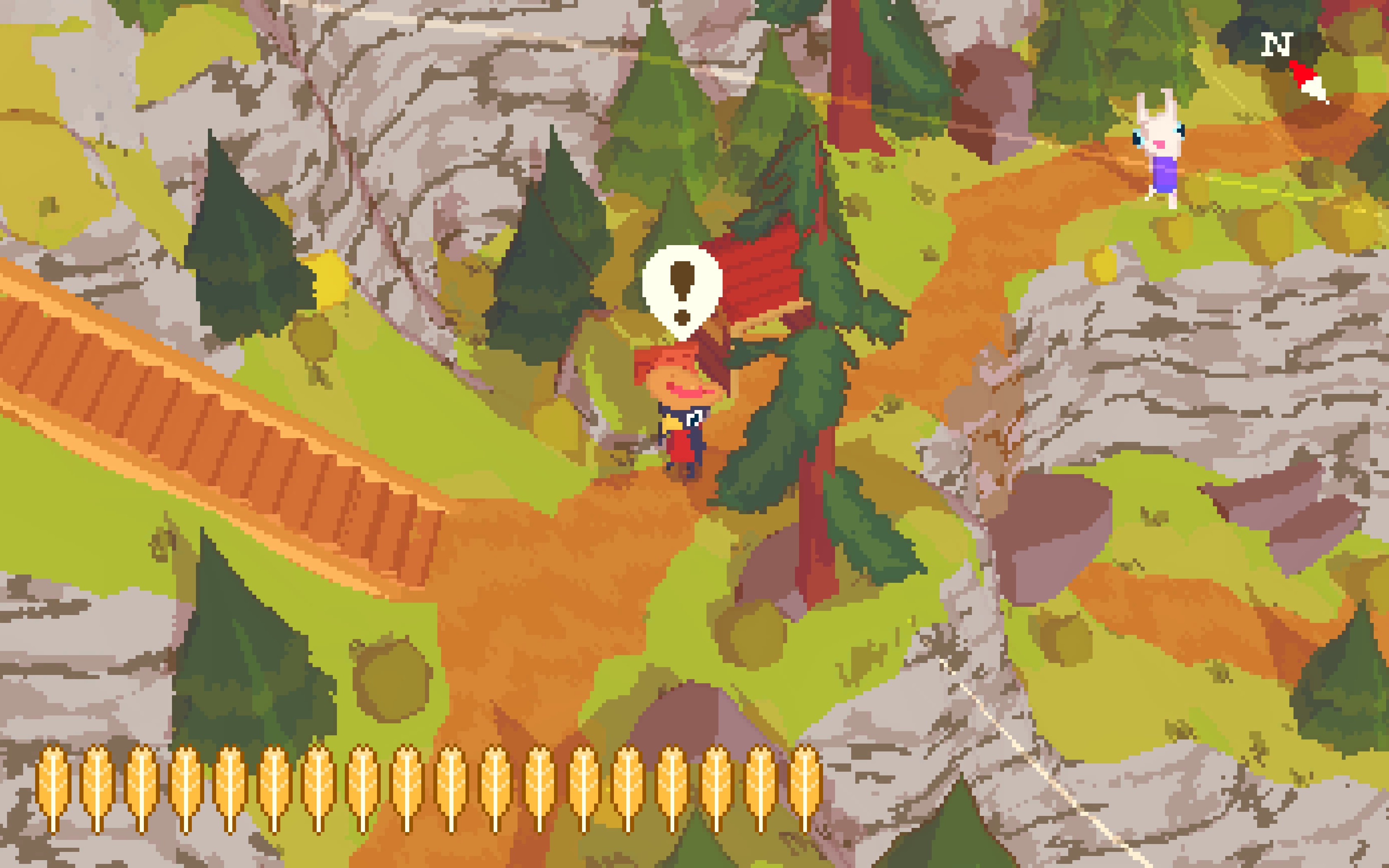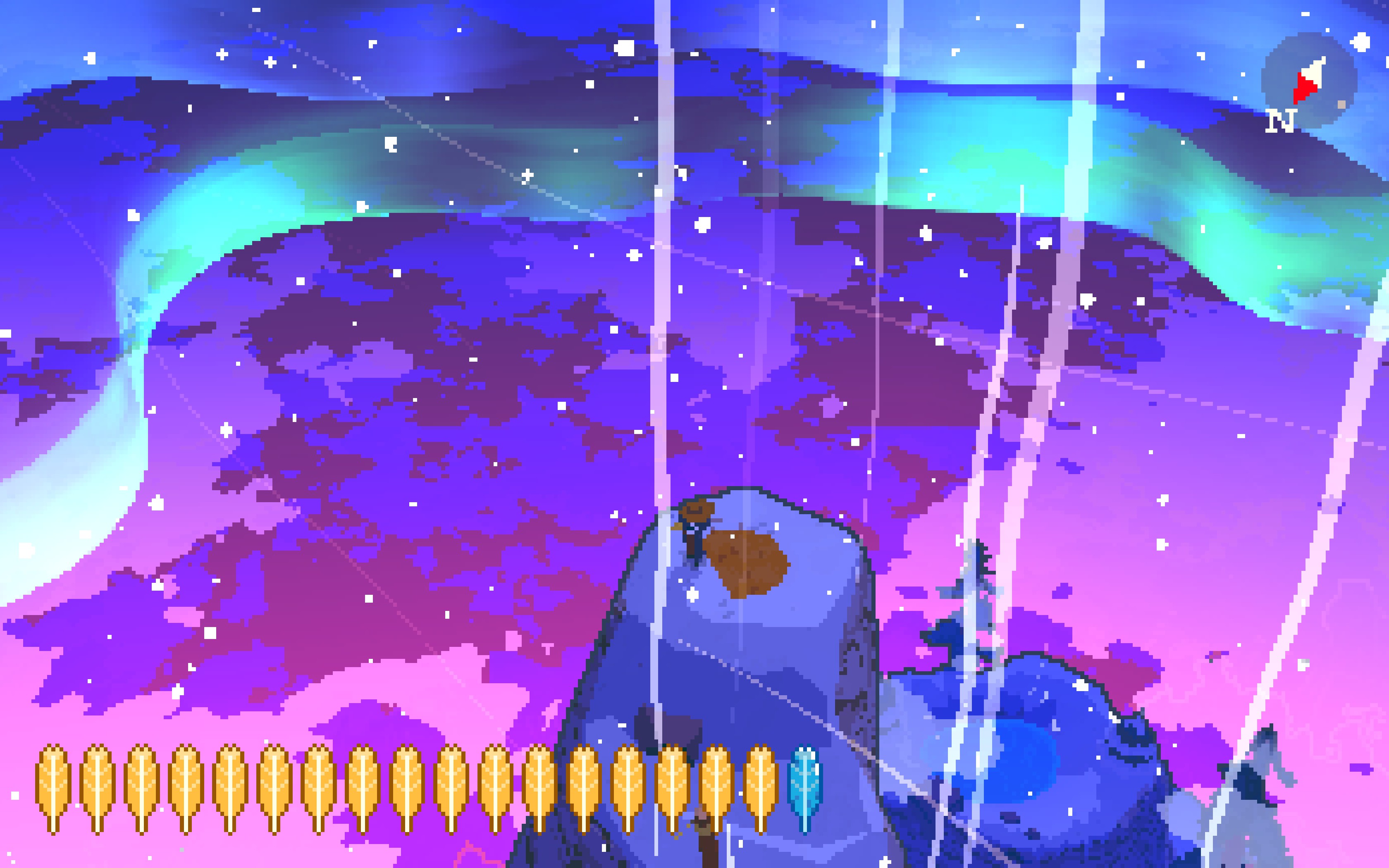2021 May 12
A Short Hike is an indie adventure and exploration game that I played recently and I want to look at how the game is designed and why it's fun. We'll discuss how the game works, its mechanics, and even some of the story elements -- so, there's gonna be spoilers. If you're looking for a relaxed time, go and play this game now (it's around three hours long)!
You play as Claire, a bird with the ability to climb and glide. Your goal is to hike to the top of Hawk Peak so you can get cell phone reception and make an important call. The game has items to collect, areas to explore, and quests you can complete for other hikers. As you do these things, you explore a beautiful island with different sections. You move in 3D space, but the game has a pixellated look. I think it looks great:

Core Loop: Explore, Collect, Climb
A core gameplay loop is the set of actions the player performs more than any other. In a short hike, the loop has three parts. You can explore the area Claire is in. You collect objects you find in that area. You climb to the next area. So, Explore -> Collect -> Climb. The more you explore, the more you'll collect money and feathers. As you get more feathers, you get more stamina and can climb longer. So you increase your stamina and opportunity to explore. This loop keeps the player engaged at every step.
The exploration is rewarding as you discover new physical features of the island and zones with their own unique character (for example, the orange islands or the rainy section of the island). It also directly rewards the player with money, seashells, particular vendors or quests with unique items, mysterious treasure maps, etc. The game teaches you about exploration right at the start. You get two choices: talk to a character (ranger may) or run down the beach where you discover a seashell. This subtle choice indicates immediately to the player that there may be collectible rewards tied to exploration. This ramps up in the later zones. For example, quests or side activities you discover can give huge rewards (like beach stickball). Exploration is satisfying, and it feels like there's enough beyond the horizon to keep you guessing and searching.
As you collect items you aren't always totally sure what their use will be. Even once you figure out that you can use money for buying feathers, you still wonder if there are other places or uses for it (there are). The developer doesn't dole out rewards in one big chunk (collect money for half the game, finally get one reward) but rather hints at them as you make your way through the game (you can buy things from a vendor here, use it in quests there). This way, collecting items produces a mystery of discovery steadily throughout the experience. Once you know that a unique vendor will sell you a cool hat for money, every collection of money is no longer just a shiny that gets thrown at you; maybe it's a cool item to make Claire look fly as fuck.
Ok so what about climbing? Well there are entire (brilliantly fun) games where the core loop is climbing and falling. Most of the challenge of the climbing in a short hike comes from the limited stamina and changing camera. As you climb, the camera often shifts to change the directional controls slightly, making reaching certain areas challenging. Sometimes getting to a spot up a cliff or ridge can be like solving a puzzle. For example, the stone tower has a special chest on top. Early on, it's possible to get to this chest with very few feathers by climbing between the windows in the tower. Later it's trivial to get on top of the tower with more feather stamina. Sometimes the climbs are simple, and sometimes it's like navigating a series of tricky cliffs. So you can treat climbing like a puzzle, or you can increase your character's power and easily skip the puzzle later. Constructing the climbing mechanic like this is satisfying and fun while still providing optionality to the player.
Each section of the core loop provides its sense of fun. When you put them together, it gives you a feeling of progression through the world.
Progression is Well Paced and Well Tweaked
Progression is the idea that your character can grow in power as you play the game. When properly done, it increases power and difficulty simultaneously to make you feel good about progressing and keep the game from becoming too easy. Progression should be something that comes naturally out of the core game loop.
The core loop in short hike doles out progression toward the goal steadily. Yet, as you grow in power, you can re-experience earlier zones with increased access. A lot of games have something like this. Ever go back to the starter zone and corpse camp some low-level player (you did that, didn't you)? Since most of the game's challenge comes from the terrain itself, it's fitting that as you increase your stamina and discover new items, you can more easily traverse the elevation of the earlier zones. You can climb up higher and then glide down or use new bouncy flowers to skip over entire areas. You can also jump down and spot things you might have missed before.
As you enter the cold biome at higher elevations, your feathers "freeze" temporarily when you use them. So while your increased traversability makes you feel as if you've grown in power and progressed, new zones tweak the mechanic to maintain a sense of difficulty and challenge. I remember games where this type of progression was lacking, and everything just got too easy as the game progressed, like total war titles where the game would turn into a slog of auto resolving battles. The thing that's cool about is that it's not just a nerf in the cold zone; it's a different mechanic. You can still use the feathers -- but they work differently now and will only recharge if you stop in a spot where Claire can get warm. Its tasteful, clever, and more power systems should try and implement these kinds of progression tweaks.
Tying it Together with Distracted Respite
I would describe the sound track as a Studio Ghibli French countryside ensemble that fits the laid back feeling of the game. It's great music to work to as well. In fact, I'm listening to it while writing this.
The story is a sequence of cute little vignettes that give you the sense of being distracted. You play the game to be immersed or distracted from reality for a little while (we call this kind of distraction "fun"). A short hike explores the idea of distraction a bit further. You play a character who's worried about a phone call but has the opportunity to be distracted by side quests from other hikers on the mountain. It's mentioned in the game several times. It breaks your immersion in the game briefly, if only to make you consider what's happening. The developer uses this trick to crack jokes. At one point, the painter laments that we can't tell what they're painting. Of course, we can't tell what they're painting. It's a tiny blob of pixels on the screen with no discernable structure. The way I can best describe this trick is a small crack in the 4th wall that you can peek through. The story reminds you that you're playing a game, being distracted, making you feel a little bit of what Claire must feel.

Fin
I mostly talked here about things that are working in the game. There's also stuff that felt kind of weird. One thing is that if you move your mouse around, Claire's gaze is supposed to move toward the mouse. However, her head spasms every which way, and it makes her look like a tiny bird rag doll. The game also repeatedly told me to press enter to run, though it just made my character jump. When I checked the bindings, it said "enter" mapped to "run," I still don't know if there's a way to run (though I did win a race quest). Sometimes it felt a little too unstructured. For example, it took me a long time to find the fishing rod. A tiny hint indicating how far away it was from the character mentioning it might have been nice (there's a few other things like this).
Ok so where does that leave us with a short hike? The core loop is fun to play. I take back my initial description of the game. The more appropriate category for it should be "3D platformer disguised as an indie adventure." But no baddies are running at you, and there's only a distant goal with almost no pressure to reach it. I think for a game with shallow pressure and low structure, it's remarkably well designed and very good at guiding me toward relaxation.
Play it. Learn from it. Enjoy it!